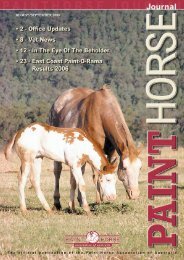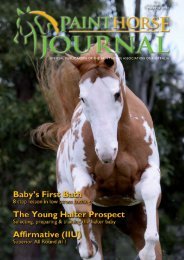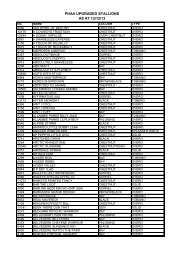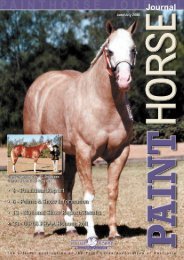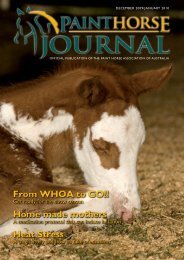PH - Paint Horse Association of Australia
PH - Paint Horse Association of Australia
PH - Paint Horse Association of Australia
Create successful ePaper yourself
Turn your PDF publications into a flip-book with our unique Google optimized e-Paper software.
In conclusion, rather than grey horses being "prone" to<br />
equine melanoma, it is more accurate to say that a<br />
syndrome exists which in its early expression changes the<br />
coat colour to grey.<br />
In some individuals the disease then progresses and<br />
primary tumours develop usually on the dock or around<br />
the anogenital area.<br />
In a further percentage <strong>of</strong> grey horses the tumours become<br />
more widespread and/or occur around the head and neck.<br />
In cases where tumours <strong>of</strong> the parotid region occur and<br />
restrict eating or breathing, or in cases where anogenital<br />
tumours complicate elimination, the animal may have to<br />
be put down.<br />
Basically, if you purchase a grey horse, there is a<br />
probability that at some stage in its life it will develop<br />
some symptoms <strong>of</strong> melanoma. It would be possible to<br />
eradicate grey horse melanoma by eliminating greys from<br />
all breeding programs, but this would be unrealistic,<br />
particularly since in a large percentage <strong>of</strong> cases the<br />
syndrome has no ill effect on the animal - there is evidence<br />
to suggest that in some populations, individuals seem more<br />
resistant to the development <strong>of</strong> tumours.<br />
Owners <strong>of</strong> grey horses should however be aware that grey<br />
horse melanoma is the result <strong>of</strong> a genetic mutation rather<br />
than a "disease" in the normally understood sense <strong>of</strong> the<br />
term, and that as such there are unlikely to be effective<br />
"cures" developed.<br />
References<br />
FINTL, C & DIXON, P.M. (2001) A review <strong>of</strong> five cases <strong>of</strong><br />
parotid melanoma in the horse, In: Equine Veterinary Education<br />
13 (1) 17 - 24<br />
FOLEY, G.L., VALENTINE, B.A. & KINCAID, A.L. (1991)<br />
Congenital and acquired melanocytomas (benign melanomas)<br />
in eighteen young horses. Vet. Path. 28, 363 - 369<br />
GOETZ, T.E. & LONG, M.T. (1993) Treatment <strong>of</strong> Melanomas<br />
<strong>of</strong> <strong>Horse</strong>s. Comp. Cont. Educ. Pract. Vet 4, 608 - 610<br />
GOWER, J (1999) <strong>Horse</strong> Colour Explained, Simon & Schuster<br />
(<strong>Australia</strong>) Pty Ltd, Sydney (pp 55 - 60).<br />
SUTTON, R.H. & COLEMAN, G.T. (1997) Melanoma and the<br />
Greying <strong>Horse</strong>, In: RIRDC Research Paper Series No 97/55 RIRDC<br />
Project No. UQ-28 University <strong>of</strong> Queensland<br />
YAGER, J.A, SCOTT, D.W. & WILCOCK, B.P. (1993) The skin and<br />
appendages, In: Pathology <strong>of</strong> Domestic Animals, Eds: K.V.F. Jubb, P.C.<br />
Kennedy and N. Palmer, Academic Press Inc., San Diego, pp 719 -721<br />
Grey <strong>Horse</strong>s and Melanoma - A Postscript<br />
Kerry Morgan, B.A. Dip Ed. January 2007<br />
The paper I wrote in 2003 put forward a theory that grey coat<br />
colouration in horses was a mutation and that "grey horse melanoma"<br />
was part and parcel <strong>of</strong> the syndrome.<br />
If you turn the question around and instead <strong>of</strong> asking "why do so<br />
many grey horses get melanoma?", you ask "why are almost all horses<br />
with melanoma grey?", you can approach the problem from a<br />
different perspective.<br />
Up till now, no model could satisfactorily answer the following<br />
questions -<br />
If melanoma is benign, how does a horse end up with numerous<br />
lesions which arise independently?<br />
Why is surgery ineffective?<br />
How does Cimetidine suppress or slow the formation <strong>of</strong> tumours?<br />
Why do greys "lose" the colour pigment from their hair? Is it in fact a<br />
"normal" process? Why does it not occur in any other species?<br />
What substance makes up the tumours?<br />
Why is the ratio <strong>of</strong> horses that develop tumours variable with breed,<br />
and why are tumours apparently less prevalent in older breeds with<br />
more grey horses? Is there an adaptation working?<br />
What, if anything, "switches on" the process? Could it be<br />
"switched <strong>of</strong>f"?<br />
Can it be prevented or delayed? How?<br />
Do all greys descend from one individual? When? And where?<br />
A study undertaken at the University <strong>of</strong> Uppsala in Sweden in 2005,<br />
with results published by Pielberg et al as Comparative linkage<br />
mapping <strong>of</strong> the Grey coat colour gene in horses, identifies the gene<br />
responsible for grey colouring in horses and states that the<br />
research suggests "that the grey phenotype is caused by a<br />
mutation in a novel gene."<br />
Research is now being undertaken in equine genetics to determine<br />
where and when this mutation occurred. This is being done partly by<br />
mathematical models, and partly by research into art and literature,<br />
examining how far back we can find representations <strong>of</strong> white or<br />
grey horses, or mention <strong>of</strong> them.<br />
Most people will recall the well-known Biblical quote:<br />
And I saw, and behold a white horse:<br />
and he that sat on him had a bow;<br />
and a crown was given unto him:<br />
and he went forth conquering, and to conquer.<br />
This has been thought to perhaps represent the image <strong>of</strong> the feared<br />
Parthian mounted archer on his white horse. Certainly white and grey<br />
horses existed during the time <strong>of</strong> the Egyptian dynasties - the<br />
evidence so far gathered is pointing to the mutation that causes grey<br />
having occurred many thousands <strong>of</strong> years ago, probably in the Middle<br />
East, and therefore probably in the ancestors <strong>of</strong> the Arabian.<br />
It will be fascinating when the puzzle is finally solved.<br />
References The Bible - King James Version, Revelation Chapter 6,<br />
verses 1 to 8<br />
Comparative linkage mapping <strong>of</strong> the Grey coat colour gene in horses<br />
Authors: Pielberg, G.; Mikko, S.1; Sandberg, K.1; Andersson, L. Animal<br />
Genetics, Volume 36, Number 5, October 2005, pp. 390-395(6)<br />
Publisher: Blackwell Publishing<br />
Four <strong>Horse</strong>men <strong>of</strong> the Apocalypse From Wikipedia, the free<br />
encyclopedia http://en.wikipedia.org/wiki/Four_horsemen_<strong>of</strong>_the_Apocalypse<br />
Kerry’s following comments: -<br />
"Please be aware also that the paper<br />
explores a theory, and that although<br />
the theory <strong>of</strong>fers what I believe is the<br />
best explanation for the apparent link<br />
between grey colour in horses, and the<br />
specific "grey horse" form <strong>of</strong> equine<br />
melanoma, research still continues into<br />
the syndrome.<br />
Since I wrote my paper, a gene<br />
mapping study done at the University<br />
<strong>of</strong> Uppsala by Pielberg et al (2005 -<br />
ref below) has indicated that the<br />
greying mechanism in horses is indeed<br />
a unique mutation.<br />
It may also be <strong>of</strong> interest to readers to<br />
know that I have recently purchased a<br />
4yo QH gelding - and he is grey."<br />
Photos attached - Welsh pony 12yrs<br />
with melanoma tumours affecting the<br />
parotid region, eye socket and jaw<br />
(Photos - author)<br />
Comparative linkage mapping <strong>of</strong> the<br />
Grey coat colour gene in horses<br />
Authors: Pielberg, G.; Mikko, S.1;<br />
Sandberg, K.1; Andersson, L.<br />
Source: Animal Genetics, Volume 36,<br />
Number 5, October 2005, pp. 390-<br />
395(6)<br />
Publisher: Blackwell Publishing<br />
26<br />
The <strong>Paint</strong> <strong>Horse</strong> Journal<br />
February - March 2007





